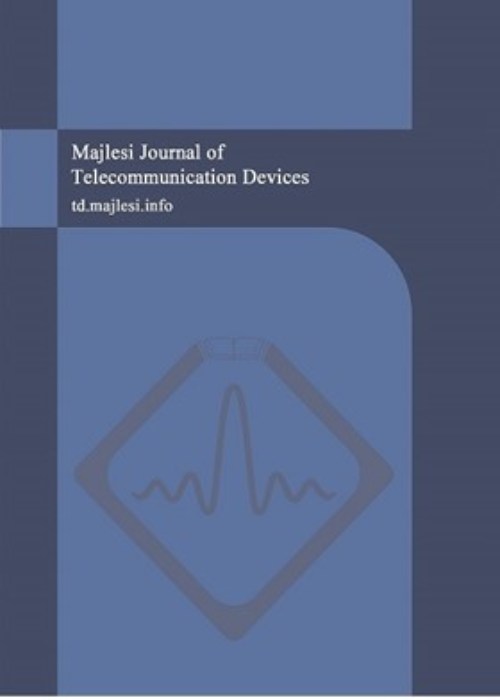فهرست مطالب
Majlesi Journal of Telecommunication Devices
Volume:1 Issue: 1, Mar 2012
- تاریخ انتشار: 1391/02/23
- تعداد عناوین: 7
-
Pages 1-6This project investigates chaos theory as a method for information cryptography in optical communication. Information security and communicated information error reduction are the main communication issues. Different methods including chaos theory have been suggested for its analysis. In addition to introducing the theory, this article investigates whether it could be used in optical communication and suggests a method to use the theory in the communication.
-
Pages 7-10The possibility of terahertz generation has been investigated from a photoconductive switch based on GaAs, gated by a femtosecond laser. The emission properties of photoconductive antenna (PCA) with low-temperature-grown (LT) GaAs have been studied. In such GaAs materials presence of the charged defects induces a redistribution of the electric field between the antenna electrodes. This effect has a huge influence on the amplitude of the radiated terahertz field. In this work we demonstrate that carrier concentration enhances radiation power. Results obtained as a function of the laser excitation power (with 100 fs rise time and 1KHz repetition rate) and carrier concentration are discussed and a comparison of the performance of these devices with a conventional antenna-type (dipole) emitter is given.
-
Pages 11-15In this paper, a new differential Colpitts voltage-controlled oscillator (VCO) is presented. The VCO is based on the gm-boosted structure to relax the oscillation start-up current requirement and reduce the DC power consumption in comparison to conventional Colpitts structures. In the proposed VCO, a tunable active inductor is utilized as a part of LC tank instead of passive inductor with constant inductance. The proposed VCO is designed and simulated in ADS in a 0.18μm CMOS process. Simulation results indicate that the proposed VCO has a wide tuning range in comparison to other reported designs while consumes less DC power.
-
Pages 16-22A vector hydrophone is composed of two or three spatially collocated but orthogonally oriented velocity hydrophones plus an optional collocated pressure hydrophone. A vector hydrophone may form azimuth-elevation beams that are invariant with respect to the sources’ frequencies, bandwidths and radial locations. This paper characterizes the minimum variance distortionless response (MVDR) beam patterns associated with a single underwater acoustic vector hydrophone located near a reflecting boundary for the far-field underwater acoustic sources.
-
Pages 23-27On low altitude radar system heavy reflective clutter from earth case saturation receiver amplifier, for stoppage receiver saturation using a crystal notch filter on input of IF stage Crystal filter having high Q and selective frequency and band width, they have high resistance for changing temperature so this filter suitable for radar receiver. In this paper we try to showing suitable method for increase Q and selective width of filter band width, to design a filter can attenuation 60dB selective band width of receiver by selective frequency. On crystal notch filter using trans for increasing circuit impedance and filter band width
-
Pages 28-32Among techniques based on power, fingerprinting method has the highest level of accuracy. In this method,error caused by the none line of sight (NLoS) between base station and user is compensable. However, some problems of the technique for implementation are: need to gather high-capacity database and necessity of update and computational complexity to estimate the position. In this paper, The similar BCCH and Cell-ID and the used modulation and received signal strength (RSS) employed for filtering existing point in database to reduce computational complexity which is a novel technique. By executing the proposed algorithm in a part of Isfahan metropolis, the calculated average error of the suggested technique is 21 meters which its error is less than other techniques.
-
Pages 33-38communication systems of high-speed railway have inherent disadvantages and advantages. The estimation error of direction-of-arrival (DOA) of desired users caused by channel feedback delay and high moving speed make the common beamforming technique of smart antennas work abnormally. Instead, the opportunistic beamforming (OBF) with dumb antennas which does not need channel feedback is proper for high-speed railway. As the system has linear topology, regular movement as well as predictable location and speed information, the OBF can be improved to adapt to this scenario. In this article, conventional OBF is first introduced to the communication systems of high-speed railway. By multiplying random complex on each transmit antenna, the channel fluctuation dynamic range is extended so that multiuser diversity can be exploited. And then location information is employed to assist the conventional one. Communication systems in high-speed railway have the advantage of predictable location and speed information. The improved OBF can perform closer to the performance of coherent beamforming. Numerical analysis and simulation results show that both two algorithms can improve the system performance significantly.


